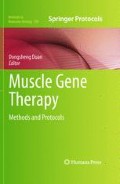Abstract
Coronary artery disease is the number one cause of morbidity and mortality in the Western world. It typically occurs when heart muscle receives inadequate blood supply due to rupture of atherosclerotic plaques. During ischemia, up-regulation of hypoxia inducible factor-1 alpha (HIF-1α) transcriptional factor can activate several downstream angiogenic genes. However, HIF-1α is naturally degraded by prolyl hydroxylase-2 (PHD2) protein. Recently, we cloned the mouse PHD2 gene by comparing the homolog gene in human and rat. The best candidate shRNA sequence for inhibiting PHD2 was inserted behind H1 promoter, followed by a separate hypoxia response element (HRE)-incorporated promoter driving a firefly luciferase (Fluc) reporter gene. This construct allowed us to monitor gene expression noninvasively and was used to test the hypothesis that inhibition of PHD2 by short hairpin RNA interference (shRNA) can lead to significant improvement in angiogenesis and contractility as revealed by in vitro and in vivo experiments.
Access this chapter
Tax calculation will be finalised at checkout
Purchases are for personal use only
References
Rosamond, W., Flegal, K., Friday, G., Furie, K., Go, A., Greenlund, K., Haase, N., Ho, M., Howard, V., Kissela, B., Kittner, S., Lloyd-Jones, D., McDermott, M., Meigs, J., Moy, C., Nichol, G., O’Donnell, C. J., Roger, V., Rumsfeld, J., Sorlie, P., Steinberger, J., Thom, T., Wasserthiel-Smoller, S. and Hong, Y. (2007) Heart disease and stroke statistics--2007 update: a report from the American Heart Association Statistics Committee and Stroke Statistics Subcommittee. Circulation 115, e69–e171.
Kim, M. C., Kini, A. and Sharma, S. K. (2002) Refractory angina pectoris: mechanism and therapeutic options. J Am Coll Cardiol 39, 923–934.
Nabel, G. J. (2004) Genetic, cellular and immune approaches to disease therapy: past and future. Nat Med 10, 135–141.
Yla-Herttuala, S. and Alitalo, K. (2003) Gene transfer as a tool to induce therapeutic vascular growth. Nat Med 9, 694–701.
Isner, J. M. (2002) Myocardial gene therapy. Nature 415, 234–239.
Luttun, A., Tjwa, M., Moons, L., Wu, Y., Angelillo-Scherrer, A., Liao, F., Nagy, J. A., Hooper, A., Priller, J., De Klerck, B., Compernolle, V., Daci, E., Bohlen, P., Dewerchin, M., Herbert, J. M., Fava, R., Matthys, P., Carmeliet, G., Collen, D., Dvorak, H. F., Hicklin, D. J. and Carmeliet, P. (2002) Revascularization of ischemic tissues by PlGF treatment, and inhibition of tumor angiogenesis, arthritis and atherosclerosis by anti-Flt1. Nat Med 8, 831–840.
Vincent, K. A., Feron, O. and Kelly, R. A. (2002) Harnessing the response to tissue hypoxia: HIF-1 alpha and therapeutic angiogenesis. Trends Cardiovasc Med 12, 362–367.
Fukuda, R., Hirota, K., Fan, F., Jung, Y. D., Ellis, L. M. and Semenza, G. L. (2002) Insulin-like growth factor 1 induces hypoxia-inducible factor 1-mediated vascular endothelial growth factor expression, which is dependent on MAP kinase and phosphatidylinositol 3-kinase signaling in colon cancer cells. J Biol Chem 277, 38205–38211.
Stolze, I., Berchner-Pfannschmidt, U., Freitag, P., Wotzlaw, C., Rossler, J., Frede, S., Acker, H. and Fandrey, J. (2002) Hypoxia-inducible erythropoietin gene expression in human neuroblastoma cells. Blood 100, 2623–2628.
Sandau, K. B., Fandrey, J. and Brune, B. (2001) Accumulation of HIF-1alpha under the influence of nitric oxide. Blood 97, 1009–1015.
Jewell, U. R., Kvietikova, I., Scheid, A., Bauer, C., Wenger, R. H. and Gassmann, M. (2001) Induction of HIF-1alpha in response to hypoxia is instantaneous. FASEB J 15, 1312–1314.
Chan, D. A., Sutphin, P. D., Denko, N. C. and Giaccia, A. J. (2002) Role of prolyl hydroxylation in oncogenically stabilized hypoxia-inducible factor-1alpha. J Biol Chem 277, 40112–40117.
Ivan, M., Kondo, K., Yang, H., Kim, W., Valiando, J., Ohh, M., Salic, A., Asara, J. M., Lane, W. S. and Kaelin, W. G., Jr. (2001) HIFalpha targeted for VHL-mediated destruction by proline hydroxylation: implications for O2 sensing. Science 292, 464–468.
Jiang, B. H., Semenza, G. L., Bauer, C. and Marti, H. H. (1996) Hypoxia-inducible factor 1 levels vary exponentially over a physiologically relevant range of O2 tension. Am J Physiol 271, C1172–C1180.
Pislaru, S., Janssens, S. P., Gersh, B. J. and Simari, R. D. (2002) Defining gene transfer before expecting gene therapy: putting the horse before the cart. Circulation 106, 631–636.
Yla-Herttuala, S., Markkanen, J. E. and Rissanen, T. T. (2004) Gene therapy for ischemic cardiovascular diseases: some lessons learned from the first clinical trials. Trends Cardiovasc Med 14, 295–300.
Wu, J. C. and Yla-Herttuala, S. (2005) Human gene therapy and imaging: cardiology. Eur J Nucl Med Mol Imaging 32 Suppl 2, S346–S357.
Huang, M., Chan, D. A., Jia, F., Xie, X., Li, Z., Hoyt, G., Robbins, R. C., Chen, X., Giaccia, A. J. and Wu, J. C. (2008) Short hairpin RNA interference therapy for ischemic heart disease. Circulation 118, S226–S233.
Miyagishi, M. and Taira, K. (2002) U6 promoter-driven siRNAs with four uridine 3′ overhangs efficiently suppress targeted gene expression in mammalian cells. Nat Biotechnol 20, 497–500.
Ruan, H., Su, H., Hu, L., Lamborn, K. R., Kan, Y. W. and Deen, D. F. (2001) A hypoxia-regulated adeno-associated virus vector for cancer-specific gene therapy. Neoplasia 3, 255–263.
Cao, F., Lin, S., Xie, X., Ray, P., Patel, M., Zhang, X., Drukker, M., Dylla, S. J., Connolly, A. J., Chen, X., Weissman, I. L., Gambhir, S. S. and Wu, J. C. (2006) In vivo visualization of embryonic stem cell survival, proliferation, and migration after cardiac delivery. Circulation 113, 1005–1014.
Acknowledgments
This work was supported in part by grants from the NIH HL095571 (JCW), NIH HL093172 (JCW), and AHA Western Postdoctoral Fellowship (MH).
Author information
Authors and Affiliations
Editor information
Editors and Affiliations
Rights and permissions
Copyright information
© 2011 Springer Science+Business Media, LLC
About this protocol
Cite this protocol
Huang, M., Wu, J.C. (2011). Molecular Imaging of RNA Interference Therapy Targeting PHD2 for Treatment of Myocardial Ischemia. In: Duan, D. (eds) Muscle Gene Therapy. Methods in Molecular Biology, vol 709. Humana Press. https://doi.org/10.1007/978-1-61737-982-6_13
Download citation
DOI: https://doi.org/10.1007/978-1-61737-982-6_13
Published:
Publisher Name: Humana Press
Print ISBN: 978-1-61737-981-9
Online ISBN: 978-1-61737-982-6
eBook Packages: Springer Protocols

